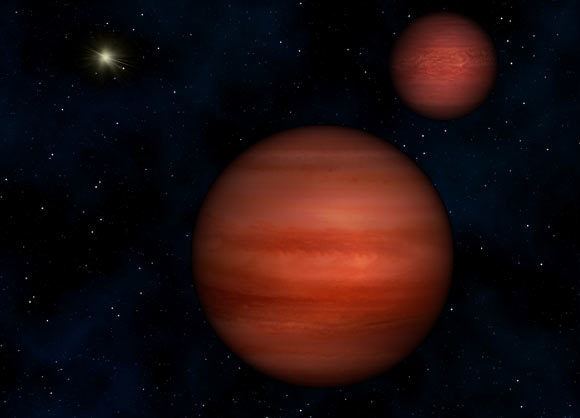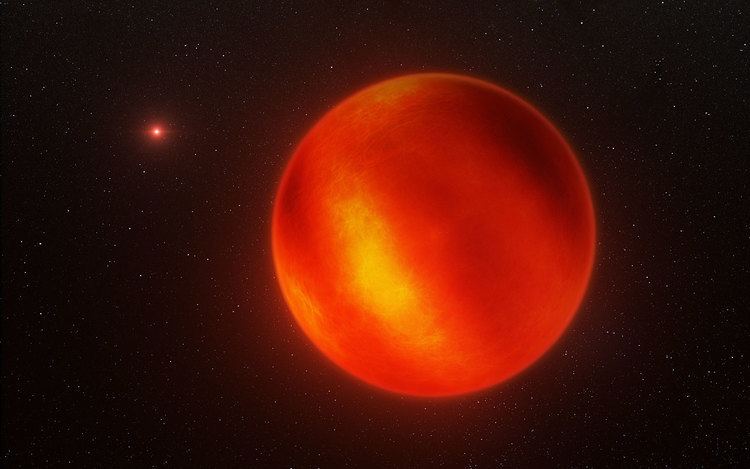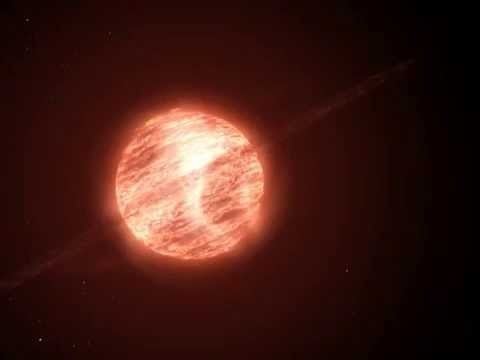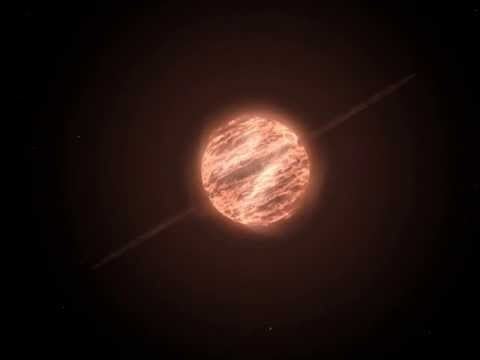Component B Observed separation(projected) 3 AU | Angular distance 1.5″ | |
 | ||
Similar WISE 0855−0714, Barnard's Star, WISE 1506+7027, YZ Ceti, Luyten's Star | ||
Luhman 16 (WISE 1049−5319, WISE J104915.57−531906.1) is a binary brown-dwarf system in the southern constellation Vela at a distance of approximately 6.5 light-years (2.0 pc) from the Sun. These are the closest known brown dwarfs and the closest system found since the measurement of the proper motion of Barnard's Star in 1916, and the third-closest known system to the Sun (after the Alpha Centauri system and Barnard's Star). The primary is of spectral type L7.5 and the secondary of type T0.5 ± 1 (and is hence near the L–T transition). Luhman 16 A and B orbit each other at a distance of about 3 AU with an orbital period of approximately 25 years.
Contents
- Brown dwarf attack luhman 16
- Discovery
- Discovery of companion
- Precovery
- Name
- Position in the sky
- Distance
- Proximity to the Solar System
- Proximity to Alpha Centauri
- Proper motion
- Radial velocity
- Orbit
- Search for planets
- Atmosphere
- Radio and X ray activity
- References

Brown dwarf attack luhman 16
Discovery

The brown dwarfs were discovered by Kevin Luhman, astronomer from Pennsylvania State University and a researcher in Penn State's Center for Exoplanets and Habitable Worlds, from images made by the Wide-field Infrared Survey Explorer(WISE) Earth-orbiting satellite—NASA infrared-wavelength 40 cm (16 in) space telescope, a mission that lasted from December 2009 to February 2011; the discovery images were taken from January 2010 to January 2011, and the discovery was announced in 2013 (the pair are the only two objects announced in the discovery paper). The system was found by comparing WISE images at different epochs to reveal objects that have high proper motions.

Luhman 16 appears in the sky close to the galactic plane, which is densely populated by stars; the abundance of light sources makes it difficult to spot faint objects. This explains why an object so near to the Sun was not discovered in earlier searches.
Discovery of companion

The second component of the system was discovered also by Luhman in 2013, and was announced in the same article as the primary. Its discovery image in the i-band was taken on the night of 23 February 2013 with the Gemini Multi-Object Spectrograph (GMOS) at the Gemini South telescope, Chile. The components of the system were resolved with an angular distance of 1.5 arcseconds, corresponding to a projected separation of 3 AU, and a magnitude difference of 0.45 mag.
Precovery

Although the system was first found on images taken by WISE in 2010–2011, afterwards it was precovered from the Digitized Sky Survey (DSS, 1978 (IR) & 1992 (red)), Infrared Astronomical Satellite (IRAS, 1983), ESO Schmidt telescope (1984 (red)), Guide Star Catalog (GCS, 1995), Deep Near Infrared Survey of the Southern Sky (DENIS, 1999), Two Micron All-Sky Survey (2MASS, 1999), and the AKARI satellite (2007).

On the ESO Schmidt telescope image, taken in 1984, the source looks elongated with a position angle of 138°. The similarity of this position angle with that of the resolved pair in the GMOS image (epoch 2013) in Fig. 1 of Luhman (2013) suggests that the time period between 1984 and 2013 may be close to the orbital period of the system (not far from original orbital period estimate by Luhman (2013)).
Name

Eric E. Mamajek proposed the name Luhman 16 for the system, with the components called Luhman 16A and Luhman 16B. The name originates from the frequently updated Washington Double Star Catalog (WDS): Luhman has already published several new discoveries of binary stars that have been compiled in the WDS with discovery identifier "LUH". The WDS catalog now lists this system with the identifier 10493−5319 and discoverer designation LUH 16.
The rationale is that Luhman 16 is easier to remember than WISE J104915.57−531906.1 and that "it seems silly to call this object by a 24-character name (space included)". The "phone number names" also include WISE J1049−5319 and WISE 1049−5319. Luhman–WISE 1 was proposed as another alternative.
As a binary object it is also called Luhman 16AB.
Position in the sky
Luhman 16 is located in the southern celestial hemisphere in the constellation Vela. As of July 2015, its components are the nearest known celestial objects in this constellation outside the Solar system. Its celestial coordinates: RA = 10h 49m 18.723s, Dec = −53° 19′ 09.86″.
Distance
The trigonometric parallax of Luhman 16 as published by Sahlmann & Lazorenko (2015) is 6999500510000000000♠0.50051±0.00011 arcsec, corresponding to a distance of 6.5166 ± 0.0013 ly (1.998 ± 0.0004 pc).
Proximity to the Solar System
Currently Luhman 16 is the third-closest known star/brown-dwarf system to the Sun after the triple Alpha Centauri system (4.37 ly) and Barnard's Star (5.98 ly), pushing Wolf 359 (7.78 ly) to the fifth place, along with the discovery of WISE 0855−0714. It also holds several records: the nearest brown dwarf, the nearest L-type dwarf, and possibly the nearest T-type dwarf (if component B is of T-type).
Proximity to Alpha Centauri
Luhman 16 is the nearest known star/brown-dwarf system to Alpha Centauri, located 3.577 light-years (1.097 pc) from Alpha Centauri AB, and 3.520 light-years (1.079 pc) from Proxima Centauri. This is due to both systems being located in neighboring constellations, in the same part of the sky as seen from Earth but Luhman 16 is a bit farther away. Before the discovery of Luhman 16, the Solar System was the nearest known system to Alpha Centauri.
Interestingly, Luhman 16 is closer to Proxima Centauri than to Alpha Centauri AB, just like Earth, despite the fact that Luhman 16 is located further from Earth than Alpha Centauri system. This is due to the fact that Luhman 16 has smaller angular distance to Proxima Centauri than to Alpha Centauri AB in Earth's sky, and this makes more contribution to the distance difference from Luhman 16 to Alpha Centauri than the distance difference between them and Earth.
Proper motion
The proper motion of Luhman 16 as published by Sahlmann & Lazorenko (2015), is about 2.75″/year, which is relatively large due to the proximity of Luhman 16.
Radial velocity
The radial velocity of component A is 23.1 ± 1.1 km/s (14.35 ± 0.68 mi/s), and the radial velocity of component B is 19.5 ± 1.2 km/s (12.12 ± 0.75 mi/s). Since values of the radial velocity are positive, the system currently is moving away from the Solar System.
Assuming these values for the components, and a mass ratio of Luhman 16 from Sahlmann & Lazorenko (2015) of 0.78, the system's barycentre radial velocity is about 21.5 km/s (13.4 mi/s). This implies that Luhman 16 passed by the Solar System around 36,000 years ago at a minimal distance of about 5.05 light-years (1.55 pc).
Orbit
In the discovery paper the orbital period estimate of Luhman 16 AB, based on its separation and the substellar masses, is about 25 years.
Mamajek (2013) discussed the elongation of the ESO 1984 optical image of Luhman 16 and similar position angle in its 1984 and 2013 images, supposing that the Luhman (2013) orbital period estimate of about 30 years is not far from the actual period.
In Burgasser et al. (2013) the orbital period estimate, based on a true semi-major axis of roughly 4 AU and equal component masses of 0.04–0.065 M☉, is 22–28 years.
According to Sahlmann & Lazorenko (2015), the mass ratio (q) of the two brown dwarfs is 6999780000000000000♠0.78+0.10
−0.09 and a face-on orbit is highly unlikely, since it requires extreme eccentricity (>0.95), but the orbit may be circular (e = 0), inclined (i = 95°), and the orbital period may be 45 years, which is slightly longer than previous estimates. This is compatible with the elongation of 1984 ESO images (this implies that in 1984 and 2013 A and B components were located in opposite directions from the photocentre — see Figure 6 — but in the ESO 1984 elongated image its bottom left part appears brighter, similar to 2013 GMOS image).
Search for planets
In December 2013, perturbations of the orbital motions in the system were reported, suggesting a third body in the system. The period of this possible companion was a few months, suggesting an orbit around one of the brown dwarfs. Any companion would need to be below the brown-dwarf mass limit, because it would otherwise have been detected through direct imaging.
Subsequent astrometric monitoring of Luhman 16 with the Very Large Telescope has excluded the presence of any third object with a mass greater than 2 MJup orbiting around either brown dwarf with a period between 20 and 300 days. Luhman 16 does not contain any close-in giant planets.
Atmosphere
A study by Gillon et al. (2013) found that Luhman 16B exhibited uneven surface illumination during its rotation. On 5 May 2013, Crossfield et al. (2014) used the European Southern Observatory's Very Large Telescope (VLT) to directly observe the Luhman 16 system for five hours, the equivalent of a full rotation of Luhman 16B. Their research confirmed Gillon et al.'s observation, finding a large, dark region at the middle latitudes, a bright area near its upper pole, and mottled illumination elsewhere. They suggest this variant illumination indicates "patchy global clouds", where darker areas represent thick clouds and brighter areas are holes in the cloud layer permitting light from the interior. Gillon et al. determined that Luhman 16B's illumination patterns change rapidly, on a day-to-day basis.
Although Luhman 16A has also been observed in the same fashion as 16B, no similar variance in illumination was found.
Radio and X-ray activity
In a study by Osten et al. (2015), Luhman 16 was observed with the Australia Telescope Compact Array in radio waves and with the Chandra X-ray Observatory in X-rays. No radio or X-ray activity was found at Luhman 16 AB, and constraints on radio and X-ray activity were presented, which are "the strongest constraints obtained so far for the radio and X-ray luminosity of any ultracool dwarf".
